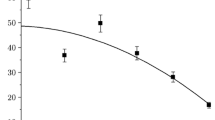Abstract
Solution combustion synthesis (SCS) is a widely recognized method to synthesize nanoscale materials. In this work, an attempt was made to analytically simulate (using the Semenov method) and evaluate the influence of preheating temperature on flame temperature as well as on physicochemical characteristics of SCS products. Preheating was found to affect combustion temperature only slightly. An increase in preheating temperature led to a decrease in the induction period due to enhanced heating rate and an increase in cooling time as a result of additional exothermic reactions taking place at higher temperatures. Variation in cooling time caused changes in composition and microstructure of product. For the first time, a mathematical model of SCS was suggested.
Similar content being viewed by others
References
Aruna, S.T. and Rajam, K.S., Mixture of fuels approach for the solution combustion synthesis of Al2O3–ZrO2 nanocomposite, Mater. Res. Bull., 2004, vol. 39, no. 2, pp. 157–167. doi 10.1016/j.materresbull. 2003.10.005
Alves, A., Bergmann, C.P., and Berutti, F.A., Novel Synthesis and Characterization of Nanostructured Materials: Engineering Materials, Berlin–Heidelberg: Springer, 2013, pp. 15–16.
González-Cortés, S.L. and Imbert, F.E., Fundamentals, properties and applications of solid catalysts prepared by solution combustion synthesis (SCS), Appl. Catal. B, 2013, vol. 452, pp. 117–131. doi 10.1016/j.apcata.2012.11.024
Mukasyan, A.S. and Dinka, P., Novel approaches to solution-combustion synthesis of nanomaterials, Int. J. Self-Propag. High-Temp Synth., 2007, vol. 16, no. 1, pp. 23–35. doi 10.3103/S1061386207010049
Varma, A., Mukasyan, A.S., Deshpande, K., Pranda, P., and Erri, P., Combustion synthesis of nanoscale oxide powders: Mechanism, characterization, and properties, Mater. Res. Soc. Symp. Proc., 2003, vol. 800, p. 113. doi 10.1557/PROC-800-AA4.1
Aruna, S. T. and Mukasyan, A.S., Combustion synthesis and nanomaterials, Curr. Opin. Solid State Mater. Sci., 2008, vol. 12, nos. 3–4, pp. 44–50. doi 10.1016/j.cossms.2008.12.002
Deshpande, K., Mukasyan, A.S., and Varma, A., Direct synthesis of iron oxide nanopowders by combustion approach: Reaction mechanism and properties, Chem. Mater., 2004, vol. 16, no. 24, pp. 4896–4904. doi 10.1021/cm040061m
Cross, A., Roslyakov, S., Manukyan, K.V., Rouvimov, S., Rogachev, A.S., Kovalev, D., Wolf, E.E., and Mukasyan, A.S., In situ preparation of highly stable Nibased supported catalysts by solution combustion synthesis, J. Phys. Chem. C, 2014, vol. 118, no. 45, pp. 26191–26198. doi 10.1021/jp508546n
Wen, W. and Wu, J.-M., Nanomaterials via solution combustion synthesis: A step nearer to controllability, RSC Adv., 2014, vol. 4, no. 101, pp. 58090–58100. doi 10.1039/C4RA10145F
Patil, K.C., Hegde, M.S., Yanu R., and Aruna, S.T., Chemistry of Nanocrystalline Oxide Materials: Combustion Synthesis, Properties and Applications, Singapore: World Scientific, 2008, ch.3.
Lackner, M., Combustion Synthesis: Novel Routes to Novel Materials, Vienna: Betham, 2010, ch.16.
Xanthopoulou, G., Thoda, O., Metaxa, E.D., Vekinis, G., and Chroneos, A., Influence of atomic structure on the nanonickel-based catalysts activity produced by solution combustion synthesis in the hydrogenation of maleic acid, J. Catal., 2017, vol. 348, pp. 9–21. doi 10.1016/j.jcat.2016.12.002
Thoda, O., Xanthopoulou, G., Vekinis, G., and Chroneos, A., Parametric optimization of solution combustion synthesis catalysts and their application for the aqueous hydrogenation of maleic acid, Catal. Lett., 2018, vol. 148, no. 2, pp. 764–778. doi 10.1007/s10562-017-2279-y
Jiang, Y., Yang, S., Hua, Z., and Huang, H., Sol–gel autocombustion synthesis of metals and metal alloys, Angew. Chem. Int. Ed., 2009, vol. 121, no. 45, pp. 8681–8683. doi 10.1002/ange.200903444
Varma, A., Mukasyan, A.S., Rogachev, A.S., and Manukyan, K.V., Solution combustion synthesis of nanoscale materials, Chem. Rev., 2016, vol. 116, no. 23, pp. 4493–14586. doi doi 10.1021/acs.chemrev.6b00279
Roth, P., Particle synthesis in flames, Proc. Combust. Inst., 2007, vol. 31, no. 2, pp. 1773–1788. doi 10.1016/j.proci.2006.08.118
Kumar, A., Wolf, E.E., and Mukasyan, A.S., Solution combustion synthesis of metal nanopowders: Nickel— Reaction pathways, AIChE J., 2011, vol. 57, no. 8, pp. 2207–2214. doi 10.1002/aic.12416
Khaliullin, Sh.M., Zhuravlev, V.D., and Bamburov, V.G., Solution-combustion synthesis of oxide nanoparticles from nitrate solutions containing glycine and urea: Thermodynamic aspects, Int. J. Self-Propag. High-Temp Synth., 2016, vol. 25, no. 3, pp. 139–148. doi 10.3103/S1061386216030031
Mukasyan, A.S., Epstein, P., and Dinka, P., Solution combustion synthesis of nanomaterials, Proc. Combust. Inst., 2007, vol. 31, no. 2, pp. 1789–1795. doi 10.1016/j.proci.2006.07.052
Heinrich, P., Course of Inorganic Chemistry, Leipzig: Akademische Verlagsgesellschaft, 1961, vol.2.
Zoubovich, I.A., Neorganicheskaya khimiya (Inorganic Chemistry), Moscow: Nauka, 1989.
Semenov, N.N., Some Problems in Chemical Kinetics and Reactivity, London: Pergamon Press, 1958, vol. 1, pp.128–145.
Prokof’ev, V.G. and Smolyakov, V.K., Unsteady combustion regimes of gasless systems with a low-melting inert component, Combust. Explos. Shock Waves, 2002, vol. 38, no. 2, pp. 143–147.
Merzhanov, A.G. and Khaikin, B.I., Theory of combustion waves in homogeneous media, Prog. Energy Combust. Sci., 1988, vol. 14, no. 1, pp. 1–98. doi 10.1016/0360-1285(88)90006-8
Ripan, R.N. and Chetyanou, I., Neorganicheskaya khimiya (Inorganic Chemistry), Moscow: Mir, 1972, vol.2.
Shea, L.E., McKittrick, J., and Lopez, O.A., Synthesis of red-emitting, small particle size luminescent oxides using an optimized combustion process, J. Am. Chem. Soc., 1996, vol. 79, no. 12, pp. 3257–3265. doi 10.1111/j.1151-2916.1996.tb08103.x
Sing, K.S.W., Reporting physisorption data for gas/solid systems with special reference to the determination of surface area and porosity, Pure Appl. Chem., 1982, vol. 54, no. 11, pp. 2201–2218. doi 10.1351/pac198254112201
Author information
Authors and Affiliations
Corresponding author
Additional information
The article is published in the original.
About this article
Cite this article
Thoda, O., Xanthopoulou, G., Prokof’ev, V. et al. Influence of Preheating Temperature on Solution Combustion Synthesis of Ni–NiO Nanocomposites: Mathematical Model and Experiment. Int. J Self-Propag. High-Temp. Synth. 27, 207–215 (2018). https://doi.org/10.3103/S1061386218040088
Received:
Published:
Issue Date:
DOI: https://doi.org/10.3103/S1061386218040088




